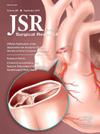肺切除术术后早期缺氧与术后肺部并发症的关系:一项回顾性队列研究
IF 1.7
3区 医学
Q2 SURGERY
引用次数: 0
摘要
尽管大量研究已经探讨了术前和术中脉搏血氧饱和度(SpO2)水平在术后肺部并发症(PPCs)中的预测作用,但相对较少关注术后早期SpO2与PPCs之间的关系。肺切除术患者术后早期常出现缺氧。本研究旨在评估术后早期缺氧是否能预测肺切除术后PPCs。材料和方法本回顾性队列研究分析了2020年1月至2023年12月接受选择性肺切除手术单肺通气患者的电子病历数据。术后早期缺氧被定义为:在麻醉后护理单元中,意识清醒、拔管呼吸室内空气至少5分钟的患者SpO2 <; 92%。采用多变量logistic回归和修正泊松回归分析来检验术后早期缺氧与术后7天内发生的PPCs之间的关系。结果共分析1147例患者。其中,156例(13.6%)患者发生PPCs, 212例(18.5%)患者术后早期缺氧。多因素logistic回归分析显示,术后早期缺氧与PPCs发生率增加独立相关(优势比5.39;95%可信区间[CI], 3.69-7.92; P < 0.001)。术后早期缺氧预测PPCs的敏感性和特异性分别为0.86 (95% CI, 0.84-0.89)和0.51 (95% CI, 0.42-0.57)。修正泊松回归分析进一步证实,术后早期缺氧显著增加PPCs风险(相对危险度4.30;95% CI, 3.26-5.67; P < 0.001)。结论术后早期缺氧在肺切除术患者中较为常见,并显著增加PPCs的发生风险。本文章由计算机程序翻译,如有差异,请以英文原文为准。
Association Between Early Postoperative Hypoxia and Postoperative Pulmonary Complications in Lung Resection Surgery: A Retrospective Cohort Study
Introduction
Despite extensive research has explored the predictive role of preoperative and intraoperative pulse oxygen saturation (SpO2) levels in postoperative pulmonary complications (PPCs), relatively little attention has been given to the association between early postoperative SpO2 and PPCs. Patients undergoing lung resection surgery often experience early postoperative hypoxia. This study aimed to assess whether early postoperative hypoxia predicts PPCs after lung resection surgery.
Materials and methods
This retrospective cohort study analyzed data from the electronic medical records of patients who underwent elective lung resection surgery with one-lung ventilation from January 2020 to December 2023. Early postoperative hypoxia was defined as an SpO2 < 92% in conscious, extubated patients breathing room air for at least 5 min in the postanesthesia care unit. Multivariate logistic regression and modified Poisson regression analyses were performed to examine the association between early postoperative hypoxia and PPCs occurring within the first seven postoperative days.
Results
A total of 1147 patients were analyzed. Of these, 156 patients (13.6%) developed PPCs, and 212 patients (18.5%) experienced early postoperative hypoxia. Multivariate logistic regression analysis revealed that early postoperative hypoxia was independently associated with an increased incidence of PPCs (odds ratio 5.39; 95% confidence interval [CI], 3.69-7.92; P < 0.001). The sensitivity and specificity of early postoperative hypoxia for predicting PPCs were 0.86 (95% CI, 0.84–0.89) and 0.51 (95% CI, 0.42-0.57), respectively. Modified Poisson regression analysis further confirmed that early postoperative hypoxia significantly increased PPCs risk (relative risk 4.30; 95% CI, 3.26-5.67; P < 0.001).
Conclusions
Early postoperative hypoxia is common among patients undergoing lung resection surgery and significantly increases the risk of developing PPCs.
求助全文
通过发布文献求助,成功后即可免费获取论文全文。
去求助
来源期刊
CiteScore
3.90
自引率
4.50%
发文量
627
审稿时长
138 days
期刊介绍:
The Journal of Surgical Research: Clinical and Laboratory Investigation publishes original articles concerned with clinical and laboratory investigations relevant to surgical practice and teaching. The journal emphasizes reports of clinical investigations or fundamental research bearing directly on surgical management that will be of general interest to a broad range of surgeons and surgical researchers. The articles presented need not have been the products of surgeons or of surgical laboratories.
The Journal of Surgical Research also features review articles and special articles relating to educational, research, or social issues of interest to the academic surgical community.

 求助内容:
求助内容: 应助结果提醒方式:
应助结果提醒方式:


